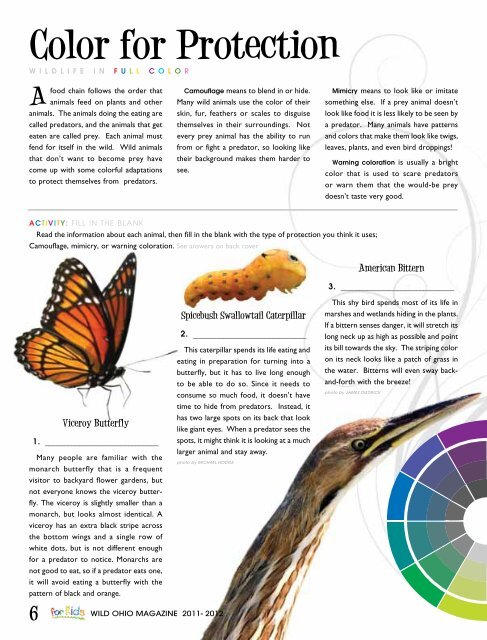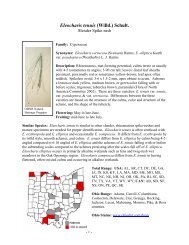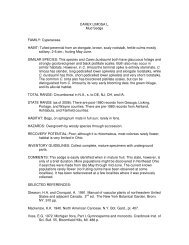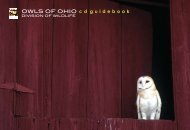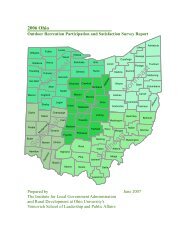Wildlife in Full Color - Ohio Department of Natural Resources
Wildlife in Full Color - Ohio Department of Natural Resources
Wildlife in Full Color - Ohio Department of Natural Resources
Create successful ePaper yourself
Turn your PDF publications into a flip-book with our unique Google optimized e-Paper software.
<strong>Color</strong> for ProtectionW I L D L I F E I N F U L L C O L O Rfood cha<strong>in</strong> follows the order thatanimals feed on plants and otheranimals. The animals do<strong>in</strong>g the eat<strong>in</strong>g arecalled predators, and the animals that geteaten are called prey. Each animal mustfend for itself <strong>in</strong> the wild. Wild animalsthat don’t want to become prey havecome up with some colorful adaptationsto protect themselves from predators.Camouflage means to blend <strong>in</strong> or hide.Many wild animals use the color <strong>of</strong> theirsk<strong>in</strong>, fur, feathers or scales to disguisethemselves <strong>in</strong> their surround<strong>in</strong>gs. Notevery prey animal has the ability to runfrom or fight a predator, so look<strong>in</strong>g liketheir background makes them harder tosee.Mimicry means to look like or imitatesometh<strong>in</strong>g else. If a prey animal doesn’tlook like food it is less likely to be seen bya predator. Many animals have patternsand colors that make them look like twigs,leaves, plants, and even bird dropp<strong>in</strong>gs!Warn<strong>in</strong>g coloration is usually a brightcolor that is used to scare predatorsor warn them that the would-be preydoesn’t taste very good.ACTIVITY: FILL IN THE BLANKRead the <strong>in</strong>formation about each animal, then fill <strong>in</strong> the blank with the type <strong>of</strong> protection you th<strong>in</strong>k it uses;Camouflage, mimicry, or warn<strong>in</strong>g coloration. See answers on back coverAmerican Bittern3. ______________________________Viceroy Butterfly1. ______________________________Many people are familiar with themonarch butterfly that is a frequentvisitor to backyard flower gardens, butnot everyone knows the viceroy butterfly.The viceroy is slightly smaller than amonarch, but looks almost identical. Aviceroy has an extra black stripe acrossthe bottom w<strong>in</strong>gs and a s<strong>in</strong>gle row <strong>of</strong>white dots, but is not different enoughfor a predator to notice. Monarchs arenot good to eat, so if a predator eats one,it will avoid eat<strong>in</strong>g a butterfly with thepattern <strong>of</strong> black and orange.Spicebush Swallowtail Caterpillar2. ______________________________This caterpillar spends its life eat<strong>in</strong>g andeat<strong>in</strong>g <strong>in</strong> preparation for turn<strong>in</strong>g <strong>in</strong>to abutterfly, but it has to live long enoughto be able to do so. S<strong>in</strong>ce it needs toconsume so much food, it doesn’t havetime to hide from predators. Instead, ithas two large spots on its back that looklike giant eyes. When a predator sees thespots, it might th<strong>in</strong>k it is look<strong>in</strong>g at a muchlarger animal and stay away.photo by MICHAEL HODGEThis shy bird spends most <strong>of</strong> its life <strong>in</strong>marshes and wetlands hid<strong>in</strong>g <strong>in</strong> the plants.If a bittern senses danger, it will stretch itslong neck up as high as possible and po<strong>in</strong>tits bill towards the sky. The strip<strong>in</strong>g coloron its neck looks like a patch <strong>of</strong> grass <strong>in</strong>the water. Bitterns will even sway backand-forthwith the breeze!photo by JAMES DIEDRICK6WILD OHIO MAGAZINE 2011- 2012


